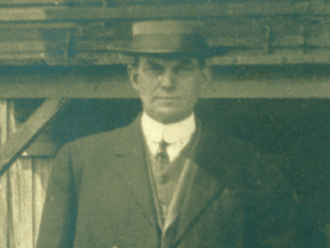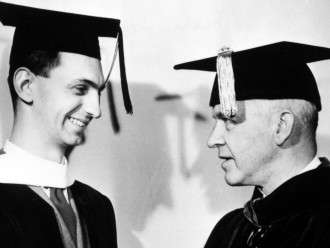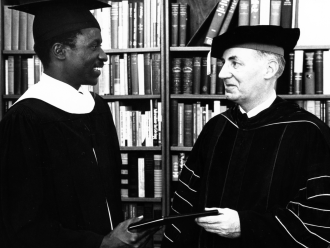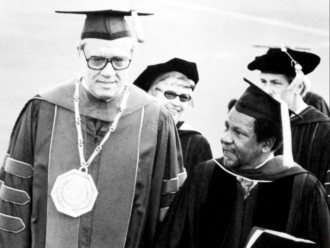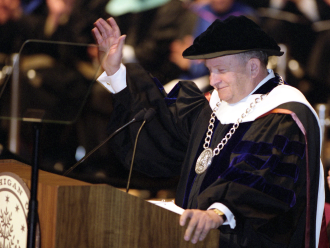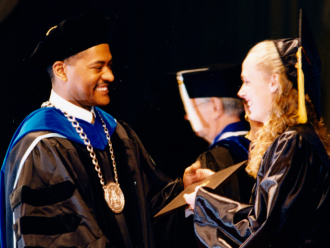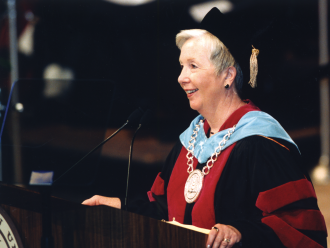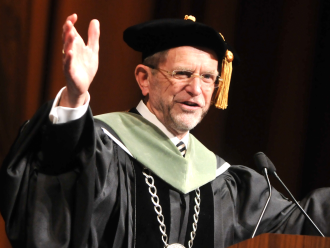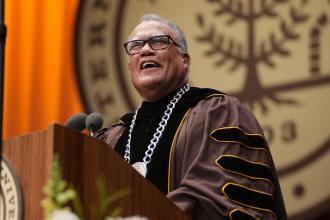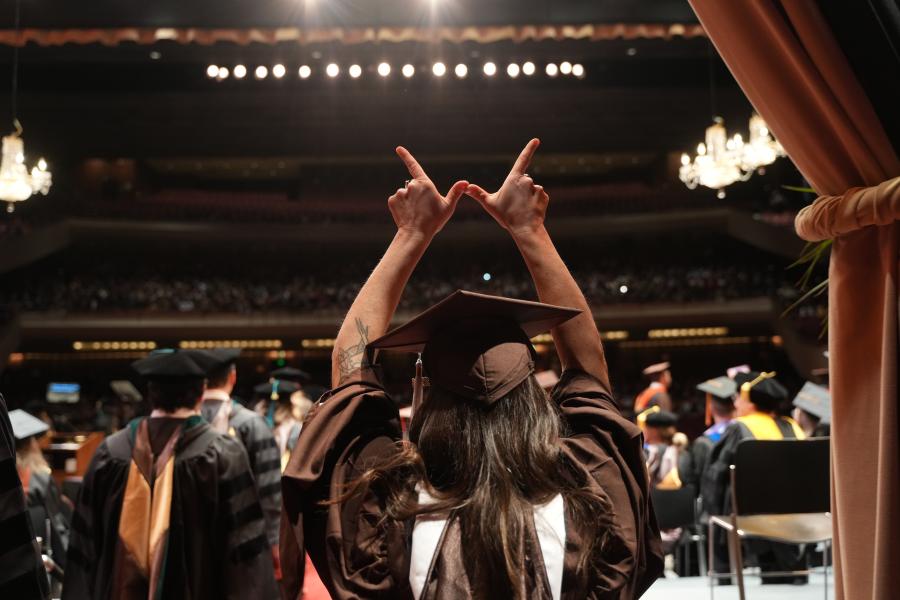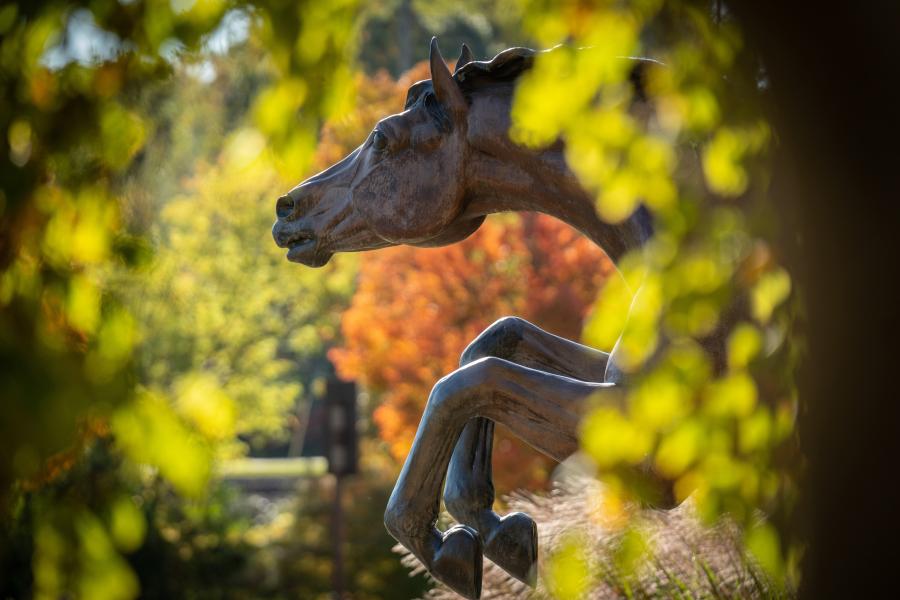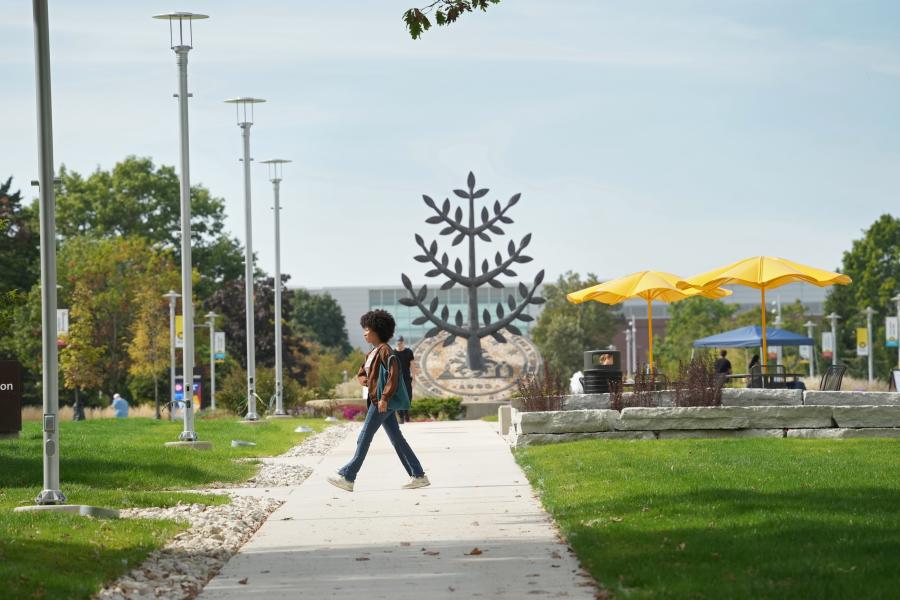Past Presidents
Dr. Dwight B. Waldo
April 1, 1904, to Sept. 1, 1936
Waldo was named principal of Western State Normal School in 1904 and served for 32 years, the final 28 under the title of president. "He was a man who had all the attributes of a successful businessman and all the qualities of a day dreamer—a realist and an idealist harmoniously blended," according to the WMU historian James O. Knauss.
Waldo instituted a progressive regime and deftly guided the institution as it grew from a two-year normal school to a four-year teachers college. He's remembered for setting a strong foundation for future growth by hiring exceptional faculty, broadening the curriculum, initiating the first building program, developing student and athletic organizations, increasing male student enrollment, and winning WMU numerous friends.
Dr. Paul V. Sangren
Sept. 1, 1936, to June 30, 1960
Sangren was named president of Western State Teachers College in 1936 and served for 24 years. Previously an instructor and administrator at the school for 13 years, his experience and institutional savvy were put to good use as WMU sought to overcome the limited progress made since 1930 because of the Depression and President Waldo's failing vigor.
To maintain the school's stature, Sangren implemented needed changes gradually and employed a democratic procedure to reduce potential friction with faculty. "As a result of this attitude," WMU historian James O. Knauss reported, "the Sangren era is noted for an immediate, rapid and continuous material expansion, to which there would be little or no opposition, and a somewhat slower start in academic, professional and administrative changes with a later relatively rapid acceleration."
Dr. James W. Miller
Jan. 1, 1961, to Feb. 28, 1974
Miller was named president of Western Michigan University in 1961 and served for 13 years, becoming known as a champion of the fine arts. Under his leadership, WMU made the transition from a teacher-training institution to a comprehensive university and witnessed a dramatic increase in enrollment, academic offerings, construction and scholarships.
Miller's tenure has been described as marked by "phenomenal growth—intellectual and physical. It has been a period without precedent and will not be repeated." Miller devoted much of his time to improving budgetary efficiency and lobbying the state Legislature for more equitable funding. He also took a great interest in the individual student, despite the unrest of the 1960s; campus beautification; and unusual and innovative academic programs that contribute to WMU's unique character to this day.
Dr. John T. Bernhard
Sept. 1, 1974, to June 30, 1985
Bernhard was named president of WMU in 1974 and served for 11 years during a time of adversity and schisms. Michigan was experiencing severe economic problems, new educational demands were being made by students and legislators alike, enrollment was stagnating and faculty morale was low. Through it all, Bernhard governed with an open atmosphere and an eye on long-range initiatives that would promote stability.
He "has given definition to the words 'civility,' 'compassion,' and 'commitment,'" one WMU trustee who served with him noted. "His commitment to excellence and his accomplishments will place him among Western's greats." Bernhard's credits include starting organized private fund raising, improving community and alumni relationships, strengthening affirmative action, expanding international education and women's athletics, and enhancing the fine arts.
Dr. Diether H. Haenicke
Aug. 1, 1985, to July 31, 1998
Haenicke was named president of WMU in 1985 and during the next 13 years, made tremendous strides in preparing the school for the 21st century. A hands-on leader with vision and drive, he steered the institution through several economic downturns and oversaw its transition from a regional state university to a nationally ranked institution.
Haenicke was often praised by WMU's governing board for having accomplished the difficult task of making, as one trustee put it, "an actual, palpable, undeniable improvement in the very stature and substance of this University." He is cited in particular for improving teaching quality at both the undergraduate and graduate levels, raising academic standards, expanding research and international programs, increasing graduate offerings, upgrading facilities, beautifying the campus, and broadening WMU's visibility throughout the state and nation.
Haencike returned to serve as interim president for the 2006-07 academic year.
Dr. Elson S. Floyd
Aug. 1, 1998, to Jan. 5, 2003
Floyd was named WMU's sixth president in 1998 and quickly made collaboration a hallmark of his administration. His talent for creating mutually beneficial partnerships with business and industry, local officials and many other constituencies has led to new cutting-edge facilities, innovative academic programs, successful regional economic development projects, and stronger legislative and community relationships.
Floyd also has focused on enhancing degree programs as well as research and technology, emphases that have helped heighten the school's academic reputation and have spurred unprecedented growth in such key areas as enrollment, private giving, and state and federal research grants. Just two years into his tenure, a former trustee declared on behalf of the institution's governing board that "Western Michigan University is very clearly one of the top institutions in the country, and President Floyd one of the top chief executives."
Dr. Judith I. Bailey
June 9, 2003, to Aug. 15, 2006
Bailey became WMU's seventh president and the first woman to hold the job in 2003, the University's centennial year. The WMU presidency was her second university leadership role, as she came to Kalamazoo from Northern Michigan University, where she had served as president for the previous six years.
Serving at a time of severe budget constraints triggered by state appropriation cuts, her three-year tenure was also marked by major steps forward as a research institution, with the creation of a Biosciences Research and Commercialization Center, the opening of new engineering and health and human services campuses and the launch of a number of research facilities. During her tenure, WMU completed its largest capital campaign ever, exceeding its $125 million goal to raise $162 million. "President Bailey has articulated a vision for the future that...is clear and compelling," said a WMU Foundation leader of her fundraising success.
Dr. John M. Dunn
July 1, 2007 to July 31, 2017
WMU's eighth president, Dunn held the reins for what is known as the Dunn Decade. It was a period characterized by dramatic expansion of professional education, nearly $500 million in infrastructure improvements, commitment to sustainability and a campus climate known for civility, diversity and a welcoming atmosphere
"He's made it a vibrant place," said another higher education leader of the campus under Dunn. "I think a lot more people have an appreciation for the quality and scope and breadth that this University has." Among major changes to academics Dunn led were the establishment of a private medical school with community partners, an affiliation with a private law school and expansion of partnerships around the globe that led to both increased international enrollment and expanded opportunity for domestic students. His tenure also was notable for development of programming to support veterans and a support program for former foster care youth that became the largest and most comprehensive program of its kind in the nation.
Dr. Edward B. Montgomery
Aug. 1, 2017, to June 30, 2025
The ninth leader of WMU, Montgomery steadily led the University to remarkable milestones, including the University's first enrollment increase in a decade, record student retention and six-year graduation rates, an all-time high in research productivity and the largest philanthropic contribution ever made for a public university in U.S. history—the $550 million Empowering Futures Gift.
Under Montgomery's leadership, student-centric efforts to elevate Western benefited current and future Broncos while also enhancing the campus environment for all. These improvements include the new WMU Student Center, the new Aviation Education Facility, the extensively renovated Dunbar Hall and the first new residence hall to be built on campus in 11 years, which is expected to be completed in 2026.


